|
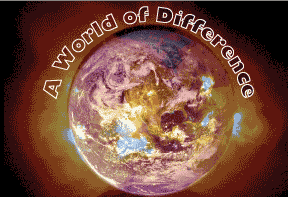
Can one person — or even a
single village — slow global warming?
by Carrie Madren, Bay Weekly staff writer
A throng of blue shirts and bright orange life preservers swarmed to the State House. To pose for a picture at Lawyers Mall, the 200 homespun activists — called out by groups like Sierra Club and Chesapeake Climate Action Network — came by faith.
They believed that by joining with fellow blue-shirted neighbors, they could show Congress how many Americans want to slow global warming. At 1,364 Step It Up rallies across all 50 states, like-minded people gathered on Climate Action Day April 14 for photos to send to Washington, in a pictorial petition.
Crowds don’t typically rally around the atmosphere — in layers hundreds of miles deep — that surrounds our planet, swirling, warming, cooling and condensing. It pours us rain. Hails on us. Blocks our sunlight. Tears our roofs off. Yet hard to grasp.
But that same thick layer of air surrounding our planet operates our global thermostat. Through the last few centuries, we’ve pushed that thermostat up. We’ve unleashed so many millions of tons of greenhouse gases that we’ve turned our world into a warmer home.
As the thermostat rises, we Earthlings must join forces to hold it down lest it expire with a world-ending whimper. We must change — or adapt to a much-changed world. Likely, we’ll have to do both.
Slowly, we’re accepting the inconvenient truth that humans can reverse the hospitable environment that’s evolved over millions of years. We can do it with one big blast from a nuclear bomb. Or we can — and are — doing it with a billion thoughtless acts that, one by one, seem innocent and harmless.
In this story, we break down global warming from that mind-boggling problem of global scale to how one person makes a difference. Starting with Earth, we scale down to the U.S. to Maryland, down through county and community levels, and finally to people.
What will it take to tackle the world’s biggest problem? The answer is you — you alongside your 300 million U.S. neighbors and six billion world neighbors.
Houston, We Have a Problem
Since 1750, the amount of carbon in our air has increased some 35 percent.
The proof of that increase is all around us, from where we live to the farthest, most secret regions. In the distant frozen parts of the world, glaciers are melting, permafrost thawing, deserts growing even drier, infectious diseases leaping old boundaries. Formerly distant changes are now knocking at our doors: weather is more erratic, storms are worse, plants and creatures are jumping zones and ever-popular waterfront is coming to the stoops of inlanders.
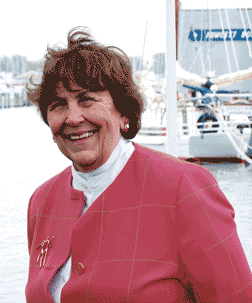 |
‘We are the only local government that has attempted to look at things that you and I can do to have an impact on the air around us,’ says Annapolis mayor Ellen Moyer. By changing simple things in our behavior, she explains, ‘we can make a difference in small ways.’
|
We’re feeling the fury of climate change in Chesapeake Country, with low-lying lands and islands swallowed by rising waters. Already, one national insurance company, Allstate, has refused to write new policies in floodable areas. We may have to get used to the kinds of storm surge powered by Hurricane Isabel in 2003.
Online gamblers can now make bets on global warming’s effects. For example, you can bet 100 to one that polar bears will become extinct by 2010, or that Manhattan will be under water before New Year’s Eve, 2011.
The odds are that our world will warm between two and 11.5 degrees, according to the authoritative Intergovernmental Panel on Climate Change of the United Nations projects, if we don’t change our ways and slow global warming.
The U.S. emits more greenhouse gases than any other country in the world. We release nearly one-quarter of the whole world’s carbon dioxide. China’s hot on our polluting heels — emitting 17 percent — and likely to catch up.
But we Americans aren’t giving ground. Each year, we release more carbon than the year before. Today, we let loose 18 percent more carbon than we did in 1990.
One round-trip, cross-country flight — at 6,000-miles — generates 5,400 pounds of carbon dioxide per traveler, according to the Vermont Earth Institute.
Carbon levels have always been in flux, because of natural carbon ebbs and flows, some caused by great volcanic eruptions. But since the beginning of the industrial age, carbon levels have shot up higher and faster than ever before. Mayor Ellen Moyer broke that bad news to the Sierra Club’s Anne Arundel Chapter last month. But she wasn’t the first to notice. Scientists now know that human pollution has exacerbated the warming.
Moyer isn’t the only Chesapeake citizen spreading the word. Del. Dana Stein of Baltimore County joined Environment Maryland last week in reporting the alarming news that 25 percent of carbon we release will still be in the atmosphere in 500 years. So our descendents 15 generations hence will still be feeling heat we’ve left behind — compounded, of course, by all the intervening generations.
Not since Adam and Eve enjoyed a garden so temperate that they wore no clothes has the human family lived in such a warm world.
Carbon is the main culprit for our warmer world. Most of the increase, says University of Maryland researcher Ben Zaitchik, can be blamed on burning fossil fuels.
Greenhouse pollutants like carbon come from as many sources as energy consumers, but by far the biggest source of carbon is electric power plants. They billow out some 40 percent of the U.S.’s global warming pollution. Mass transportation spews another 33 percent, and 20 percent of that comes from the cars, SUVs and trucks we drive. Industry releases 17 percent, our homes six percent and our businesses five percent.
Our appetite for fossil fuels — our biggest source of energy and, refined as gas, the energy that drives our cars and trucks — may be our downfall.
Global Warming Takes the Limelight
In just four months, 2007 has become the year of global warming. Al Gore’s Academy Award-winning documentary An Inconvenient Truth gathers crowds at community meetings. At Smithsonian Environmental Research Center and Calvert Marine Museum, scientists use it to help us see the problem. In this year’s just-ended General Assembly, lawmakers mulled over but couldn’t pass a Global Warming Solutions Act.
Global warming reached the limelight two years ago. Three forces pushed it forward, according to Mike Tidwell of Chesapeake Climate Action Network, headquartered in Tacoma Park.
First, in 1989 Bill McKibben published The End of Nature. That book — cited as the first on global warming written for you and me — scared people with the real ways that our contributions to the atmosphere will change life as we know it.
Next, according to McKibben, Hurricane Katrina opened the door and Al Gore walked through it.
“Those two events have really propelled a paradigm shift about climate change,” says Tidwell. “So if you combine all this, the continuing avalanche of appalling scientific data, the strange weather, you get to where we are.”
Climate change has hit closer to home since the millennium, as well. In Chesapeake Country, it started with the storm surge of Hurricane Isabel.
“I can’t say that in 2003, North Beach residents made the connection with global warming,” says former Mayor Mark Frazier, whose town was inundated so citizens saw nature’s power first hand. “But now, the theory of global warming is on people’s minds.”
More storms followed.
“The hurricane season of 2005 really freaked people out,” says Tidwell. Four major hurricanes hit the U.S. that year. “Of the six most powerful ever recorded in the last 150 years,” Tidwell says, “three happened in just 52 days.”
Thinking Big as the Sky
We can harness rivers. We’ve sheered off mountaintops. Made deserts grow green. In the struggle of humans to rule nature, we’ve changed the atmosphere. But we haven’t figured out how to control it.
To correct centuries of polluting, we’ll have to think big. At least as big as we’ve ever thought before.
To help us think big — and get a handle on an amorphous, astronomic problem — Princeton University professor of mechanical and aerospace engineering Robert Socolow devised a scheme of 15 strategies to reduce carbon emissions. Those wedges, as he calls them, can slow the heavy, swirling atmosphere of gases. But these wedges aren’t your average slice of pie.
Wind could make one wedge, Socolow says. A full wedge of wind energy — some two millions turbines — would require land the size of Wyoming. Nuclear power could make another wedge, but we’d need about 700 new 1,000-megawatt plants to displace coal plants, according to Socolow.
“For the next 50 years,” Socolow writes, “the task is to achieve about seven wedges by avoiding about 175 billion tons of carbon emissions.”
So counterbalancing pollution will take many giant steps by many people.
Many plans — like Socolow’s million wind turbines — require millions, even billions of dollars.
“We’re going to have to invest a lot of money,” says Climate Action’s Tidwell.
Kumar Barve, majority leader of the Maryland House of Delegates, told Tidwell that it would cost some $350 billion to give a $5,000 rebate to every American who buys a hybrid car, about the difference between a regular car and a hybrid model. That’s the cost so far of the war in Iraq.
But the difference hybrids make would be just as big.
“If every car or truck in America 10 years from now had a hybrid engine — no better or worse than the one that’s in my Toyota Prius now,” Tidwell says, “we’d cut our energy use in half.”
State of Maryland Affairs
You’d think big thoughts would start at the federal level. But often, that’s not the direction energy flows for change. Most of America’s giant steps — from disease eradication to dam building to nuclear power to space exploration — began with the military, often as offshoots of wars. Nationally, we’ve dragged our feet on finding new sources of energy.
“In the absence of federal action, Maryland must take steps,” said Del. Stein, who helped release a carbon report last week.
Maryland government has stepped up — timidly — to fight a global battle.
The Global Warming Solutions bill proposed in February in the General Assembly might have helped reduce Maryland’s global warming pollution to 1990 levels by 2020.
The new law would have put us on par with California, a state that’s already pledged to reduce global warming emissions by 20 percent by 2020.
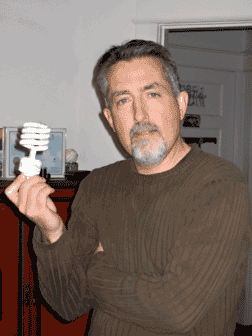 |
‘We are the only local government that has attempted to look at things that you and I can do to have an impact on the air around us,’ says Annapolis mayor Ellen Moyer. By changing simple things in our behavior, she explains, ‘we can make a difference in small ways.’
|
“The bill didn’t pass,” said Stein, a sponsor. “But we hope it will next year.”
Advocates like Brad Heavener of Environment Maryland help keep Maryland lawmakers focused. Heavener has devised a state-size wedge, or series of strategies, to cut greenhouse gas emissions. One of the strategies was the Greenhouse Gas Initiative.
In 2006, Maryland joined seven neighbor states in the Regional Greenhouse Gas Initiative, a pact to cap global warming emissions from state power plants, and reduce those polluting rates by 10 percent by 2019.
A second part of the strategy was getting the General Assembly to approve the Clean Cars Act. It passed. Now, we’ve got to use more renewable, cleaner energy.
Maryland is among 20 states that have committed to using some renewable energy — though in that select group Maryland ranks last in percent of renewables required. Our 7.5 percent renewables by 2021 recently increased to 9.5 percent, rising with a two percent solar use requirement just adopted by General Assembly. That small increase didn’t budge Maryland from last place.
But those steps only make up a fraction of a wedge.
“We need a big statewide energy efficiency program to upgrade home appliances, industrial motors and insulation in buildings,” says Heavener. “We need to double the state’s renewable energy standards.”
Doubling would take us from 9.5 to roughly 20 percent renewable sources in our energy portfolio.
“We should really be doing 15 to 20 percent by 2020,” the activist says of our need to increase our renewable energy use.
Del. Stein says our ideal commitment to renewable energy would be 20 percent.
Another fraction of the wedge is stronger building codes. Part of Heavener’s plan includes a rule that all new buildings should be green structures.
After seven years, Chesapeake Bay Foundation still stands out as a rare green building, with its geothermal heating, large windows, solar panels, compost toilets, renewable materials like cork flooring and more. Montgomery Park, which houses the Maryland Department of the Environment in Baltimore, is a regional example of green building, with its green roof, stormwater reuse system and recycled construction materials.
The best changes that a building can make for cleaner air are within the infrastructure, says David Pratt, president of the Baltimore chapter of the Green Building Council.
“Invest in a higher quality heating and ventilation system,” he says, “plus reuse materials, allow more daylight into a building and purchase materials locally,” so that materials don’t have to be shipped in.
Montgomery County passed a law last year that all new large office buildings and apartment complexes must follow green building guidelines.
Greener buildings — and the other parts of our state wedge — must start with a cleaner foundation. A wedge, experts reiterate, must satisfy our energy hunger with something other than dirty-burning fossil fuels.
It’s the least we can do, say global warming warriors. Maryland — the third most vulnerable state to rising tides, after Florida and Louisiana — has a lot to lose with 3,500 miles of floodable shoreline.
Annapolis and Global Warming
Annapolis knows about floodable shoreline. During Isabel, so much water surged through City Dock that kayaks took to the streets. The storm surge didn’t knock down houses, as it did in North Beach, but it flooded low-lying businesses and displaced Annapolis Maritime Museum.
In 2005, Annapolis mayor Ellen Moyer was among 50 mayors invited to the Sundance Film Festival, where she saw one of the first live presentations by Al Gore. It was there that the Academy Award-winning film was conceived, at the audience’s suggestion.
Ideas she learned there inspired her to create a city that could resist climate change.
“Climate change impacts all of us,” says Moyer, who first became interested in environmental issues when, as first lady of Annapolis, she advocated Lady Byrd Johnson’s Keep America Beautiful plan — a 1960s’ initiative that advocated access to water and small parks.
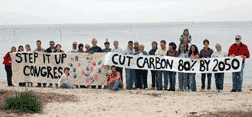 |
‘People say there’s nothing we can do. But something like Step It Up shows that you can do something.’
–Emelia Brumbaugh, age 16, Fairhaven
|
Moyer became one of Gore’s first 50 disciples. A three-day training in Nashville by the Climate Project, hosted by Gore, authorized her to give global warming lectures using Gore’s photos, graphs and anecdotes.
Now, more Annapolitans — including spokesman Ray Weaver, former Del. Dick D’Amato and director of the Department of Neighborhood and Environmental Programs Mike Mallinoff — have been commissioned to be emissaries of Gore’s message. They’re among some 1,000 presenters nationwide who deliver the inconvenient truth. Another 85 trained lecturers teach Australia and another 200 operate in the United Kingdom. Trainees, like Moyer, applied online — in a competitive applicant pool — and were offered training based on their geographic diversity, plans to give the presentations, types of communities they can reach and more.
Annapolis joined Aspen, Colorado, as the first two cities to join the World Wildlife Fund’s Power Switch Program. Both cities agree to purchase 20 percent of municipal electricity from renewable sources and increase energy efficiency by 15 percent, all by 2020.
“We also did a program that said plant a tree and drive 10 miles less, per week,” Moyer said.
Last year, Annapolis planted over 1,000 trees; the goal is to plant another 4,000 by 2009.
“We’re running out of places we can put those additional 4,000 trees,” Moyer says. Now, tree canopy covers some 41 percent of the city. The city’s goal is 50 percent under cover.
Since Moyer’s conversion, Annapolis boasts 75 rain gardens, requires replacements trees, uses alternative-fueled cars and will soon total three green roofs: the new police station, Severn Savings Bank and the Back Creek Park education center. Some city employees even get around on scooters.
Moyer has taught her Cloud Nine air pollution lesson to every fourth grade in Anne Arundel County’s 81 elementary schools. She encouraged kids to make an eight-week family clean-air plan, with goals like share a ride to work or school.
“We are the only local government that has attempted to look at things that you and I can do to have an impact on the air around us,” Moyer says. By changing simple things in our behavior, she explains, “we can make a difference in small ways.”
Reaching Critical Mass
Will our global village be able to act in time to avoid catastrophe? Only if we reach critical mass. At that tipping point, when enough people — or the right people — work to fight climate change, then we’ll be able to slow the rising heat’s disastrous consequences. Tidwell of Chesapeake Climate Action Network thinks that we’re almost at critical mass.
But it takes millions — billions, even — of individuals converted, concerned and serious.
One of them is Cherie Yelton, an Annapolis Step It Up rally organizer and Broadneck High School parent, who brought the school’s environmental club to lobby Senate president Mike Miller and Sen. John Astle.
“I decided I wanted to do something,” Yelton says. “I think it’s serious. I’m looking at my birdfeeder and there’s a woodpecker and some other little birds. The Intergovernmental Panel on Climate Change reports just came out to say that there could be a 20 to 30 percent species loss in the next 20 years. It’s really tragic. We should have respect for our place.”
April 14, Yelton joined local green groups Cool Cities, Audubon Naturalist Society and the St. John’s Students for a Sustainable Future to ask Marylanders to send a message to national lawmakers. Their photo will help persuade lawmakers that more and more Americans demand that Congress avoid — at least buffer — global catastrophe.
Similar gatherings yielded more photos for Congress as some 21 other Maryland cities sent their pictures.
Farther south, in Fairhaven, some 35 neighbors stormed the community beach for a clean-up, then took their own photo to send to D.C.
“It was empowering because people say there’s nothing we can do. But something like this shows that you can do something,” said Emelia Brumbaugh, a junior at Southern High School who helped organize the clean-up and photo for D.C. legislators. “You can add your message to one bigger message to Congress.”
In the 1,364 nationwide Step It Up gatherings, hometown activists joined to demand their government slash global-warming emissions by 80 percent by 2050.
Grassroots Strength
Such smaller efforts to fight global warming serve two purposes. First, you create a bandwagon that invites neighbors — in a community of interest or geography — on board to fight global warming.
“If someone paints their house, someone mows their lawn and you find people out in the community doing things, [neighbors] want to be part of the team,” says Farley Peters, of Fairhaven, who works across the nation to strengthen regional communities of interest. Neighbors “start to understand that it not only benefits them, but benefits the community. There’s a collective reward.”
Second, towns like Annapolis become models for other communities, attracting the attention of powerful legislators in Congress, who make the national laws.
That’s the goal, according to Climate Action’s Tidwell, because local initiatives create momentum and put pressure on those with power to limit tons of greenhouse gases.
“Communities are making voluntary choices,” he says, “but we need national standards. People like Moyer are coming up with their own policies because there’s no leadership coming from Washington.”
Besides getting positive support and recognition, says Peters, becoming part of a larger network helps magnify and leverage the work of individual communities.
Other social movements in the past — civil rights, the women’s movement — first called for change through many multiples of smaller groups.
This effort to fight climate change is rising the same way, from the grassroots up.
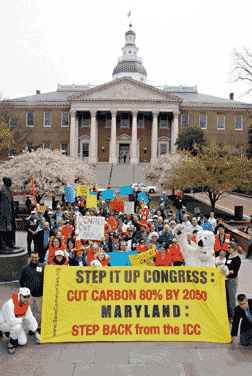 |
photo by Ward Morrison
|
Like Mayor Moyer in Annapolis, local jurisdictions across the country have raised the bar for their own small pieces of the Earth. It’s a trend that leads cities and counties to tackle problems both national and global.
Anne Arundel County joined in when County Executive John Leopold bought into the U.S. Mayor’s Climate Protection Agreement, signed by 400 mayors and three county executives from all 50 states, including Annapolis Mayor Ellen Moyer, former Baltimore Mayor Martin O’Malley and mayors from Chevy Chase, College Park, Gaithersburg, Mount Rainier, Sykesville and Takoma Park. The agreement pledges towns or counties to meet or beat the rules in the 2005 Kyoto Protocol, which sets limits to reduce global warming emissions by seven percent below 1990 levels by 2012.
By joining the U.S. Mayor’s agreement, we added weight to the critical mass needed to tip the scales.
One Among Many
So if it takes a society to rein in millions of tons of carbon, does one person really make a difference?
Yes, and no.
We do need local leaders, but, as Tidwell says “we’re not going to get there with a lot of Ellen Moyers doing their part.” We’ll need nationwide — and worldwide — commitment to curb carbon and other greenhouse gases.
Turning out your lights when you leave a room or buying a hybrid won’t save a polar ice cap. But the multiplication of individual efforts will slow emissions.
Tidwell likens the nation’s needed commitment to nationalism in past eras.
“During World War II, our nation committed itself to defeating Fascism. The scale of the conflict was so enormous that everybody had to participate,” he says. “Those who couldn’t fight built the weapons to fight, and those who couldn’t do that planted victory gardens and gave up rations, bought saving bonds. That’s how we triumphed. Could we have done it if only 10 percent of Americans were involved? It’s the same situation with global warming.”
So our patriotic duty is to make energy-saving changes to our lives, he says.
When thousands of individuals strive for a common goal — like defeating segregation, gaining women’s rights and turning against smoking — a movement gains critical mass.
The most important thing one person can do is to join a community action group that’s fighting global warming. We’re entering an era of civil rights scale, in a struggle for security and future prosperity.
Though Mayor Moyer preaches small individual actions to her fourth grade students, she does say that the way Annapolis will make a difference in the world is through demonstrating climate stewardship.
“I think we [the City of Annapolis] are an example and a peer model,” says Moyer. “We’ve had other cities come here and see what we’re doing.”
So the lesson here is, do your part in the choices you make. Can you afford a hybrid? Can you walk to the store instead of drive? Can you turn off unneeded lights in your home? Challenge yourself to use less energy.
Slowing global warming takes looking at yourself — and your community — as part of a bigger, endangered village. When we’ve ingrained simple changes into our everyday lives, we can be part of the solution.
Now’s the Time
Whatever we do, we’ll have to act fast.
“The longer we wait,” says Jennifer Bronder of Environment Maryland, “the harder our task will be to reduce global warming.”
If we drag our feet, we’ll have to face hard truths. Glaciers will disappear from Glacier National Park, according to the U.S. Geological Survey. A third to a half of animal species could be wiped out by 2050, according to the Environmental Defense Fund. A three-foot sea-level rise would flood Ocean City and Annapolis City Dock.
In 2050, our human numbers will brink nine billion. Now’s the time.
|